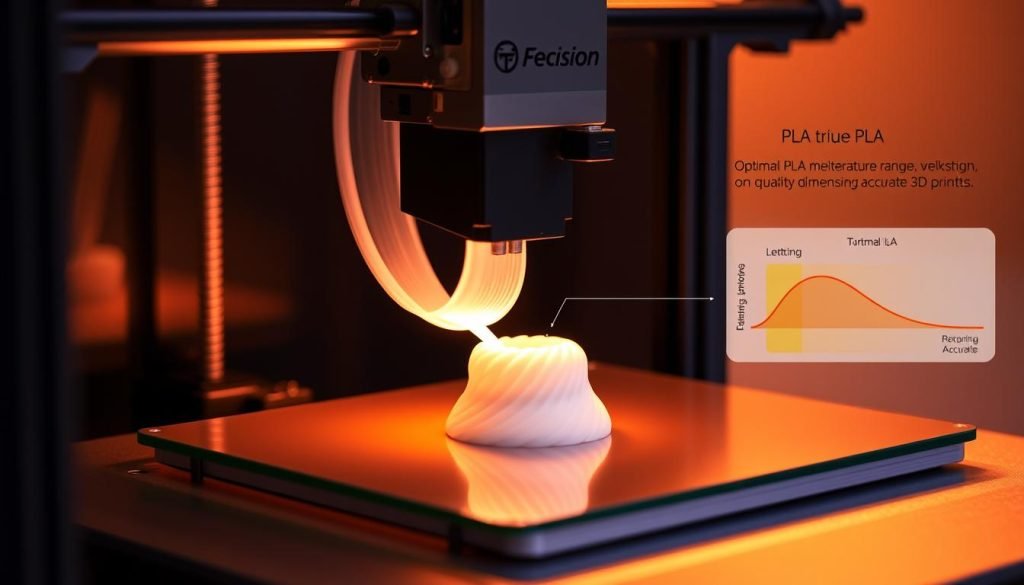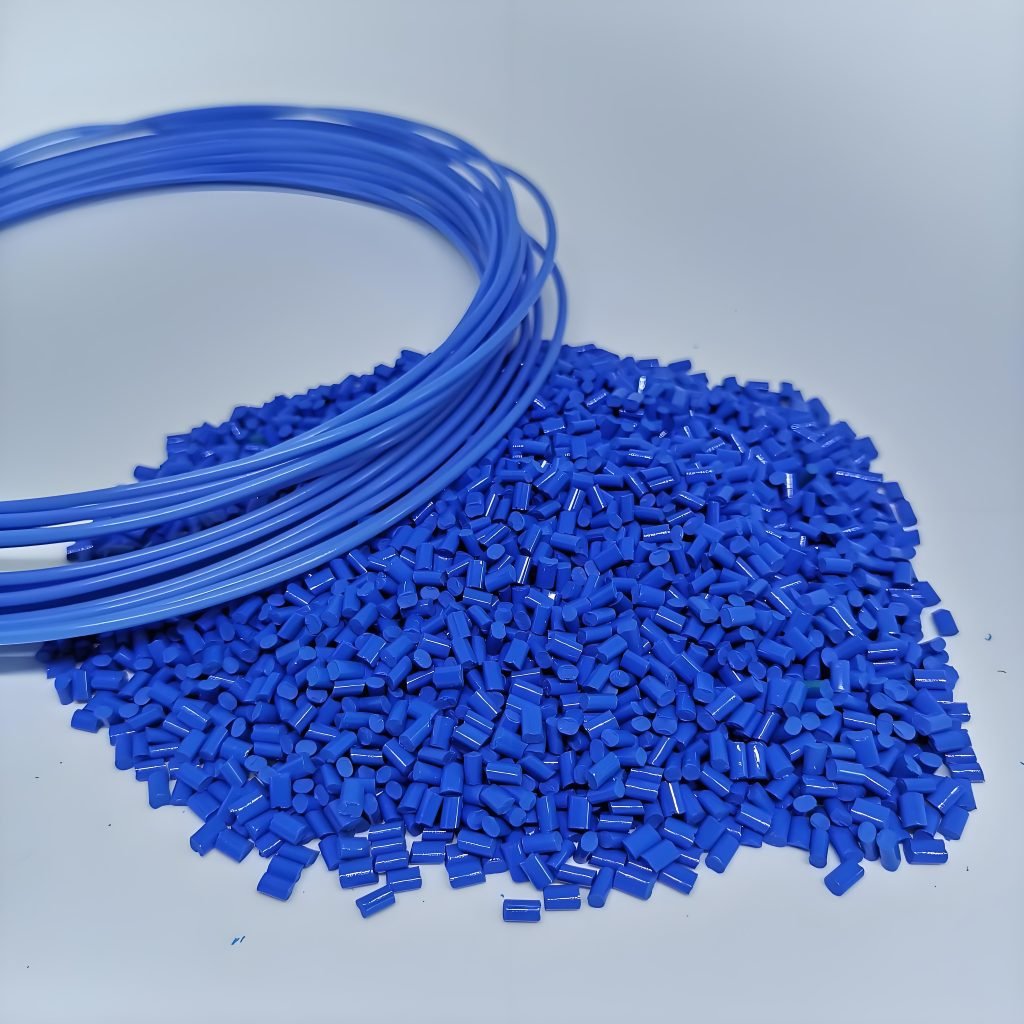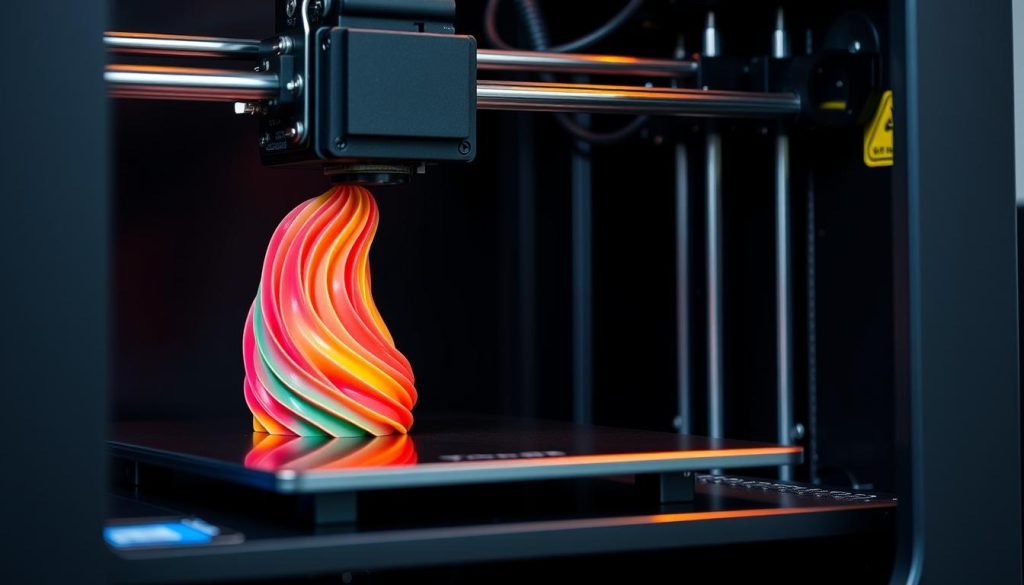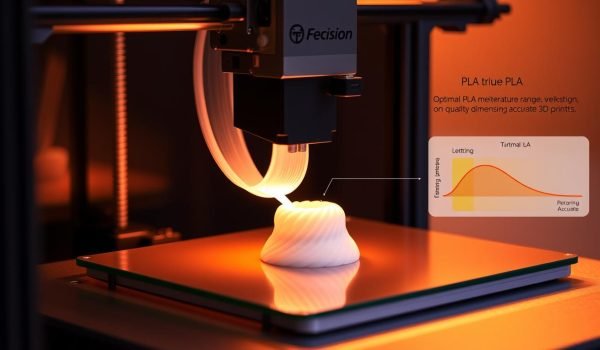
Are you struggling to achieve the perfect print with your 3D printing projects? Understanding the melting point of your printing material is crucial for success.
Polylactic acid, or PLA, is one of the most commonly used thermoplastics in 3D printing, known for its ease of use and affordability. Its popularity stems from being both environmentally friendly and accessible to beginners.
The temperature at which PLA melts directly impacts the quality and structural integrity of your prints. By grasping the properties of this material, you can optimize your printing temperature and achieve better results.
This guide will walk you through the essentials of working with PLA, from its melting behavior to practical tips for improving your 3D printing projects.
Understanding PLA Material
Polylactic Acid, commonly referred to as PLA, is a biodegradable thermoplastic that has become a staple in the 3D printing community. As a material derived from renewable resources such as cornstarch, sugarcane, or tapioca roots, PLA offers a sustainable alternative to traditional petroleum-based plastics.
What is Polylactic Acid (PLA)?
PLA is produced through the fermentation of plant starch, which is then polymerized to create a versatile material suitable for various applications, including 3D printing filament. Its production process and biodegradable nature make it an attractive option for those looking to reduce their environmental footprint.
Why PLA is Popular in 3D Printing
PLA has gained tremendous popularity in the 3D printing community due to its ease of use, low cost, and good print quality. It prints at relatively low temperatures, exhibits minimal warping, and produces less odor during printing, making it ideal for home and office environments. Additionally, PLA is available in a wide variety of colors and finishes, offering users a range of creative options.
Key Properties of PLA for Manufacturing
The properties of PLA are crucial in determining its suitability for different manufacturing applications, particularly in 3D printing. Understanding these properties can help you make informed decisions about when to use PLA.
Physical and Mechanical Properties
PLA exhibits impressive physical and mechanical properties, making it suitable for a wide range of manufacturing applications. It offers good rigidity with a Young’s modulus ranging from 2.7 to 16 GPa, and moderate tensile strength comparable to PET plastic. However, PLA tends to be more brittle with less flexibility, making it excellent for applications requiring dimensional stability but less ideal for parts that need to bend or flex.
Thermal Characteristics
PLA’s thermal characteristics include a glass transition temperature of approximately 60-65°C and a melting point range of 150-180°C. This allows for relatively low-temperature processing while still producing durable parts. However, one limitation of PLA material is its relatively low heat resistance, as printed parts can begin to deform when exposed to temperatures above the glass transition point.
Biodegradability and Sustainability
The biodegradability of PLA is one of its most significant advantages from a sustainability perspective. It can break down into lactic acid under proper industrial composting conditions, unlike conventional plastics that persist in the environment. PLA’s production from renewable agricultural resources rather than petroleum makes it a more sustainable choice for manufacturing, with a significantly lower carbon footprint compared to many traditional plastics.
Despite its environmental benefits, it’s worth noting that PLA requires specific industrial composting facilities to properly biodegrade and won’t simply break down in a backyard compost pile or landfill. This highlights the need for appropriate waste management infrastructure to fully leverage PLA’s sustainability advantages.
The Science Behind PLA Melting Point
The melting behavior of PLA is a complex phenomenon influenced by its molecular structure. As a semicrystalline polyester, PLA consists of long chains of lactic acid molecules bonded together. This molecular arrangement plays a crucial role in determining its melting point.
Molecular Structure and Melting Behavior
PLA’s molecular weight significantly influences its melting point. Generally, higher molecular weight PLA exhibits a higher melting point and improved mechanical properties. The material exists in different stereochemical forms, including PLLA, PDLA, and PDLLA, each with slightly different melting characteristics due to variations in their molecular arrangement.
Crystallinity and Its Effect on Melting
Crystallinity plays a crucial role in determining PLA’s melting behavior. More crystalline regions within the polymer require higher temperatures to melt compared to amorphous regions. The degree of crystallinity in PLA can vary from 0-40% depending on processing conditions and can be manipulated to achieve specific material properties for different applications.
How to Measure PLA’s Melting Point
Differential Scanning Calorimetry (DSC) is the standard scientific method for precisely measuring PLA’s melting point. This involves gradually heating a small sample while measuring heat flow to identify the endothermic peak that indicates melting. For practical 3D printing purposes, temperature towers provide a more accessible way to determine the optimal printing temperature for a specific PLA filament.
The transition temperature between solid and liquid states isn’t a single point for PLA but rather a range. The glass transition temperature (Tg) around 60-65°C marks when the material begins to soften, and the true melting point (Tm) between 150-180°C when crystalline regions fully melt. Understanding this temperature range is essential for optimizing 3D printing processes with PLA.
What Is The PLA’s Melting Point?

To work effectively with PLA in 3D printing, it’s essential to know its melting point. PLA, or Polylactic Acid, is a popular biodegradable thermoplastic used in various 3D printing applications. Its melting behavior is a critical aspect of its processing characteristics.
Standard Melting Point Range
The standard melting point range for PLA typically falls between 150°C and 180°C. However, this range can vary slightly depending on the specific formulation, additives, and molecular weight of the filament. Understanding this melting point range is crucial for setting proper extrusion temperatures during 3D printing. Printing too far below this range can result in incomplete melting and poor layer adhesion, while printing too far above it can cause degradation of the material.
Glass Transition Temperature vs. Melting Point
It’s also important to distinguish between PLA’s glass transition temperature and its melting point. The glass transition temperature, around 60-65°C, is when the material begins to soften and become pliable. In contrast, the melting point is when PLA fully transitions to a liquid state. This distinction is vital for understanding how PLA behaves during the 3D printing process.
Factors Affecting PLA’s Melting Point
The melting point of PLA filament is not a fixed value; it’s affected by several key factors that can impact your 3D printing projects. Understanding these factors is crucial for optimizing your printing process and achieving the best results.
Molecular Weight and Additives
The molecular weight of PLA significantly impacts its melting point. Higher molecular weight PLA typically has a higher melting point and better mechanical properties, but it may require higher printing temperatures. Additionally, manufacturers often incorporate additives into PLA filament, such as pigments, plasticizers, or stabilizers, to modify its properties. These additives can either increase or decrease the melting point of PLA, depending on their specific characteristics and concentrations.
For instance, specialty PLA filaments like wood-filled, metal-filled, or carbon fiber-reinforced varieties have different melting behaviors compared to pure PLA due to the presence of additional materials in the polymer matrix.
Filament Quality and Manufacturing Process
The quality of PLA filament plays a crucial role in consistent melting behavior. Higher quality filaments maintain tighter diameter tolerances and more consistent material composition, resulting in more predictable melting points. The manufacturing process, including cooling rates during filament production, can affect the crystallinity of PLA, which in turn influences its melting point and overall thermal behavior during printing.
Environmental Conditions During Storage
Environmental conditions during storage significantly impact PLA’s printing performance. PLA is highly hygroscopic, meaning it readily absorbs moisture from the air, which can lower its effective melting point and cause quality issues. Humidity exposure can lead to hydrolysis of the polymer chains, potentially degrading the material and altering its melting characteristics over time if not stored properly. Proper storage in airtight containers with desiccants and protection from UV light helps maintain consistent melting properties and extends the shelf life of PLA filament.
By understanding and controlling these factors, you can optimize your PLA 3D printing process, achieve more consistent results, and improve the overall quality of your printed objects.
Optimal Temperature Settings for PLA 3D Printing
PLA 3D printing temperature settings are a critical factor in ensuring high-quality prints and minimizing potential issues. To achieve the best results, it’s crucial to understand the optimal temperature settings for your PLA filament.
Nozzle Temperature Recommendations
The optimal nozzle temperature for PLA typically ranges from 180°C to 220°C, with most users finding the sweet spot around 200-210°C for standard PLA filaments. It’s advisable to start with the manufacturer’s recommended temperature and then adjust in 5°C increments based on print quality.
Lower temperatures may reduce stringing but can cause poor layer adhesion, while higher temperatures improve layer bonding but may increase oozing. Different colors and brands of PLA may require slightly different temperature settings, with darker colors sometimes needing higher temperatures than lighter ones due to differences in colorant additives.
Heated Bed Temperature Guidelines
While PLA can print on an unheated surface, using a heated bed temperature between 40°C and 60°C significantly improves first layer adhesion and reduces the likelihood of warping or detachment during printing. However, setting your print bed temperature too high (above 70°C) can be counterproductive, potentially causing the bottom layers to remain too soft and leading to elephant’s foot deformation at the base of prints.
Cooling Fan Settings for Best Results
Cooling fan settings play a crucial role in PLA printing success. Unlike ABS, which prefers minimal cooling, PLA benefits from substantial cooling to quickly solidify each layer and maintain dimensional accuracy. The recommended approach is to run cooling fans at 0-20% for the first 1-2 layers to ensure good bed adhesion, then increase to 100% for the remainder of the print to achieve the best surface quality and detail preservation.
For small, detailed parts or bridging sections, maximum cooling is essential to prevent sagging, while larger, solid sections may benefit from slightly reduced cooling to improve layer bonding. Finding the optimal balance of nozzle temperature, bed temperature, and cooling settings is key to achieving the best results with PLA printing, often requiring experimentation with each new filament brand or type.
Common PLA Melting Point Problems in 3D Printing

PLA’s melting characteristics can significantly impact the 3D printing process, causing issues if not managed properly. Understanding these challenges is crucial for achieving high-quality prints.
Oozing and Stringing Issues
Oozing and stringing are common problems when printing with PLA at temperatures that are too high for the specific filament. These issues manifest as thin strands of plastic between separate parts or unwanted blobs on the print surface. To resolve oozing problems, try gradually reducing your nozzle temperature in 5°C increments until the issue improves. Optimizing retraction settings to pull back the filament when the nozzle moves across empty space can also help.
Layer Adhesion Problems
Layer adhesion problems typically occur when printing PLA at temperatures that are too low. Signs include visible separation between layers, easy delamination when stress is applied, and overall weakness in the vertical direction of prints. If you’re experiencing poor layer adhesion, incrementally increase your printing temperature while ensuring your printer’s cooling fan isn’t running too high, as excessive cooling can prevent proper bonding between layers.
Warping and Dimensional Accuracy
Warping, while less common with PLA than with other materials like ABS, can still occur with large prints or when printing in cold environments. This happens when different parts of the print cool at different rates, causing internal stresses. To combat warping issues, ensure your print bed is properly heated (45-60°C), consider using a brim or raft for better adhesion, and try to maintain a consistent ambient temperature around your printer.
Troubleshooting Temperature-Related Issues
When troubleshooting temperature-related issues, a systematic approach works best. Create a temperature tower test print that tests a range of temperatures in a single print to identify the optimal temperature for your specific filament. Dimensional accuracy problems can occur when PLA is printed at temperatures that are too high, causing the material to flow too freely and resulting in parts that exceed their intended dimensions.
If your PLA prints are losing shape after completion, this indicates the parts are being exposed to temperatures near or above PLA’s glass transition point (60-65°C). Keep finished prints away from heat sources and direct sunlight to prevent deformation.
Advanced Techniques for Working with PLA Melting Point
To optimize your PLA 3D printing experience, it’s essential to understand advanced techniques related to its melting point. Mastering these techniques can significantly enhance the quality of your prints.
Temperature Towers and Calibration
Temperature towers are crucial for optimizing PLA printing. These specialized test models feature identical geometries printed at different temperatures as the tower rises, allowing you to visually identify the ideal temperature for your specific filament. Modern slicing software like Cura, PrusaSlicer, and Simplify3D offer built-in temperature tower generators or plugins that automatically insert temperature change commands at specified heights.
Retraction Settings Optimization
Retraction settings optimization is closely tied to temperature management. The ideal retraction distance and speed depend on your printing temperature, with higher temperatures typically requiring more aggressive retraction settings to prevent oozing. Advanced users can implement variable temperature printing, where different parts of a model are printed at different temperatures to optimize both strength and appearance.
Post-Processing Techniques Based on Thermal Properties
Post-processing techniques for PLA often leverage its thermal properties. Heat guns can be used at temperatures just above PLA’s glass transition point (around 60-65°C) to smooth surfaces without completely melting the material. Annealing is another advanced thermal treatment where PLA prints are heated in an oven to just below their melting point, increasing crystallinity and improving heat resistance and strength.
Applications of PLA Based on Melting Point Properties
The unique melting characteristics of PLA open up a range of uses in different industries. PLA’s melting point properties make it suitable for various applications where its thermal characteristics are advantageous.
Ideal Use Cases
PLA is ideal for applications requiring detailed models, prototypes, and decorative items due to its excellent surface finish and dimensional accuracy. It excels in educational environments because of its low printing temperature, minimal odor, and relative safety. Architectural modeling is another ideal use case, as PLA’s stiffness and ability to hold fine details allow for precise scale models.
Limitations Due to Thermal Properties
PLA’s limitations become apparent in functional parts that might experience temperatures above 60°C, such as automotive components or outdoor installations in warm climates. PLA will begin to lose shape and structural integrity when exposed to heat, making it unsuitable for items like hot drink containers or parts near heating elements.
Industry-Specific Applications
Despite its limitations, PLA has found numerous industry-specific applications. Medical modeling for surgical planning benefits from PLA’s biocompatibility and ability to be sterilized at low temperatures. The food industry uses PLA for disposable packaging and utensils, leveraging its plant-based origin and low melting point. Rapid prototyping across multiple industries represents a widespread application of PLA, where its ease of printing and good detail reproduction allow designers to quickly iterate through design concepts.
Comparing PLA Melting Point with Other 3D Printing Materials
When it comes to 3D printing, the choice of material can significantly impact the outcome of your project. Understanding how PLA compares to other common 3D printing materials in terms of melting point is essential for making informed decisions.
PLA vs. ABS: Temperature and Performance Differences
PLA and ABS are two of the most commonly used 3D printing materials, but they have distinct differences in terms of melting point and performance. PLA prints at a temperature range of 180-220°C, whereas ABS requires a higher temperature range of 220-250°C. This difference makes PLA more accessible for printers with lower temperature capabilities, reducing energy consumption. However, ABS offers superior heat resistance and better impact strength, making it suitable for applications where these properties are crucial.
PLA vs. PETG: Melting Point Comparison
PETG is another popular 3D printing material that represents a middle ground between PLA and ABS. With a melting point around 260°C and typical printing temperatures of 230-250°C, PETG offers better heat resistance than PLA while being easier to print than ABS. Unlike PLA, PETG maintains good flexibility without brittleness and offers excellent layer adhesion, making it preferable for functional parts that need to withstand stress or impact.
When to Choose PLA Over Other Materials
You should choose PLA when ease of printing, dimensional accuracy, and aesthetic appearance are priorities. PLA remains the material of choice for beginners, educational settings, or detailed models where its lower melting point allows for precise control and minimal warping. For outdoor applications or parts exposed to mechanical stress or temperatures above 60°C, materials like ABS, PETG, or nylon are generally better choices despite their higher printing temperatures and more demanding printing conditions.
The decision between PLA and other materials often comes down to balancing the convenience of PLA’s lower melting point against the performance requirements of the final application. By understanding the differences in melting points and performance characteristics, you can make informed decisions about the best material for your 3D printing needs.
Conclusion
Mastering PLA’s melting point is crucial for high-quality 3D prints. Optimize temperature settings for excellent detail and accuracy in PLA prints, ensuring best results with proper heated bed and cooling configurations.




